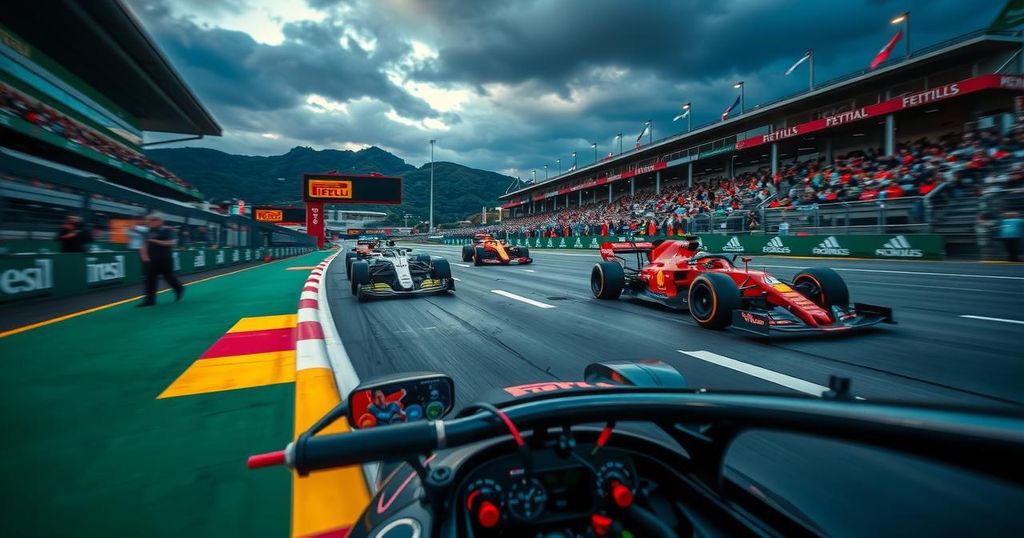Broadcasting Uncertainties Amidst F1’s North American Finale: A Look at Brazil and the U.S. Television Landscape
This article discusses the implications of uncertain broadcasting agreements for Formula 1 in Brazil and the United States as the series concludes its Americas triple-header with the Brazilian Grand Prix. Band faces challenges with its contract in Brazil, while potential rival Globo looks to reclaim rights after 2025. Conversely, ESPN has successfully dominated U.S. broadcasts, yet the future remains uncertain with potential for new bidders. The developments impact both local viewership and the overall broadcasting strategy for the sport.
As the Formula 1 season rounds off its North American leg with the Brazilian Grand Prix, the spotlight shifts to the uncertain future of broadcasting arrangements in both Brazil and the United States. The closing race at Interlagos follows a thrilling streak of three consecutive races in the Americas, including the recent victory by Carlos Sainz in Mexico and the US Grand Prix in Austin. This period of heightened interest in Formula 1, with competitive championships still unfolding, coincides with conflicting reports regarding television rights contracts that continue until the end of 2025. In Brazil, local network Band faces challenges fulfilling its broadcasting agreement launched in 2022 that covers all Grand Prix events until 2025. Reports indicate that Band is struggling to meet financial obligations under the current deal, prompting speculation about a potential termination of the contract. On the other hand, Globo, Brazil’s largest television network, is anticipated to reclaim F1 broadcasting rights in 2026 and may also broadcast the 2025 season should Band’s situation change. Freelance F1 journalist Julianne Cerasoli noted that an agreement between Globo and Liberty Media exists to air 15 races free-to-air, pending the termination approval of Band’s contract. In the United States, ESPN’s broadcasting rights emerged from a lack of traditional fees since resuming coverage in 2018, with rights acquired for approximately $90 million annually from 2022 through 2025. The network has enjoyed substantial success, experiencing record viewership last year. Despite these positive trends, there remains a possibility that ESPN may lose its broadcasting rights in 2026 should other networks choose to bid for the lucrative opportunity, with sources estimating a 50/50 likelihood for renewal. With significant changes looming over F1’s television landscape in both Brazil and the United States, the upcoming races will unfold amidst heightened awareness of these developments. The potential rise of Brazilian driver Gabriel Bortoleto may amplify local interest and impact broadcast negotiations. This evolving scenario underscores the complex interplay between competitive motorsport and its commercial broadcasting framework.
Formula 1 has seen substantial growth in popularity, particularly in North America, leading to increased scrutiny of broadcasting rights in these key markets. The Brazilian Grand Prix concludes a trio of races across the continent that have captivated audiences, yet it arrives amidst uncertainty over the local broadcasting agreements. Band has faced internal struggles in maintaining its broadcasting contract, all while Globo is poised to reclaim rights for future seasons. Simultaneously, the successful partnership between F1 and ESPN in the United States highlights the sport’s increasing presence, with the possibility of new bidders also emerging on the horizon. Understanding these dynamics is crucial to grasping the implications for both domestic and international viewership landscapes.
In summary, as Formula 1 wraps up its North American segment at the Brazilian Grand Prix, concerns regarding broadcast deals in key markets like Brazil and the United States become prominent. Band’s precarious financial situation may lead to a shift in Brazilian broadcasting, with Globo potentially set to take over. In the U.S., the continued popularity of F1 raises the stakes for future broadcast rights discussions. The evolving landscape positions the sport for potential transformation as it navigates its commercial interests against the backdrop of ongoing competitions.
Original Source: www.autosport.com




Post Comment